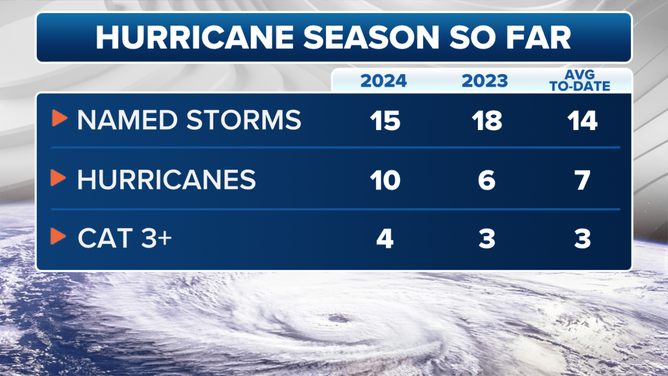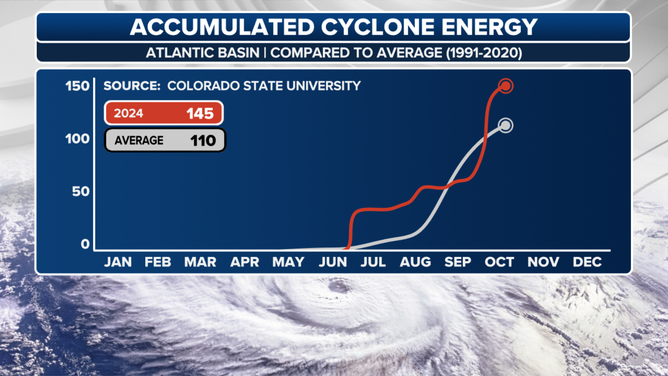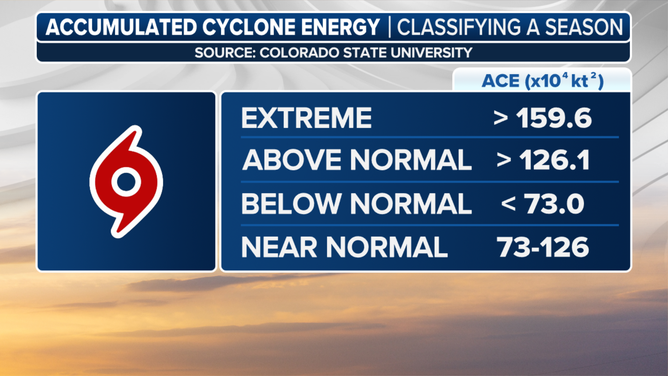Hurricane season nearing 'extreme' levels even after sluggish summer
By just the number of named storms, the hurricane season is still lagging behind bullish preseason forecasts, but using a formula known as ACE, the season could now be approaching "extreme" levels.
What makes an 'active' hurricane season?
Recent tropical activity has pushed the current hurricane season back above average, but by at least one measurement, it may still reach 'extreme' levels.
The start of this hurricane season in early summer was marked by somber predictions of a "hyperactive" year, with more than two dozen models and agencies unanimous in their above-average forecasts.
A budding La Niña combined with record water temperatures across the Atlantic Basin was seen as a slam dunk for tropical development. Hurricane Beryl’s record-setting, rapidly intensifying journey into Category 5 status at the start of July added fuel to the fire.
Then the tropics went quiet for several weeks in the heart of summer. Persistent Saharan dust in the tropical Atlantic and other unusual atmospheric conditions conspired to put the lid on hurricane development. The season drifted back toward an average count.
But as the end of September neared and the calendar turned to October, the tropics roared back to life, taking advantage of better atmospheric conditions and still-roasting water temperatures. Powerful hurricanes Helene and Milton left trails of devastation behind.
Has the late surge made up for lost time?
By the sheer count of storms, the season has pushed back above average.
"So far this season, Mother Nature has produced 15 storms that were strong enough to get a name," FOX Weather Hurricane Specialist Bryan Norcross said. "Ten reached hurricane strength, which is the highest percentage of named storms to hurricanes since the 1940s when Hurricane Hunter missions began."

(FOX Weather)
The average by now is 14 named storms, but only seven to reach hurricane strength.
But most of the robust preseason forecasts predicted at least 20 named storms.

2024 Hurricane Forecast from several agencies
(FOX Weather)
"The seasonal hurricane forecasts issued last spring were widely panned as a big bust during the long storm-formation hiatus in August and early September," Norcross said. "In actual fact, they were pretty good. While they drastically overestimated the number of named storms, they had the number of hurricanes in the ballpark. And it's hurricanes that count."
Especially this year, as between Milton and Helene, it may go down as among the top three or four most costly hurricane seasons.
ACE is not in the hole
But there is another measurement that speaks to the intensity of the season aside from just a raw count. Tropical meteorologists at Colorado State University (CSU) use a formula called Accumulated Cyclone Energy — or ACE.
It’s a complex formula that takes into account each tropical cyclone’s maximum sustained wind speed and duration. (For the math wizards, it’s the sum of the squares of the cyclone’s sustained wind speeds in knots every 6 hours while the storm has at least tropical-storm-force winds, and then divide by 10,000 to make it a simpler index.)

(FOX Weather)
After falling below average in late August into much of September, the index rocketed back above average with Helene and Milton and got another boost from recent storms Nadine and Oscar.
The Index sits at 145 as of Wednesday, which is not only well above the average of 110 at this time, but is approaching the mark of what CSU would classify as an "extreme" season of 159.6.

(FOX Weather)
And while there are no tropical disturbances in the Atlantic Basin right now, signs are growing that more tropical development may occur at the start of November.
TROPICAL TROUBLE MAY BE BREWING AGAIN FOR THE FINAL MONTH OF HURRICANE SEASON
But whether the ACE reaches extreme levels, or the storm count ultimately matches the preseason bullish forecasts, for those affected by Helene or Milton or even Beryl and Debby, it’s already been an impactful season no matter how the rest of the calendar shakes out.
